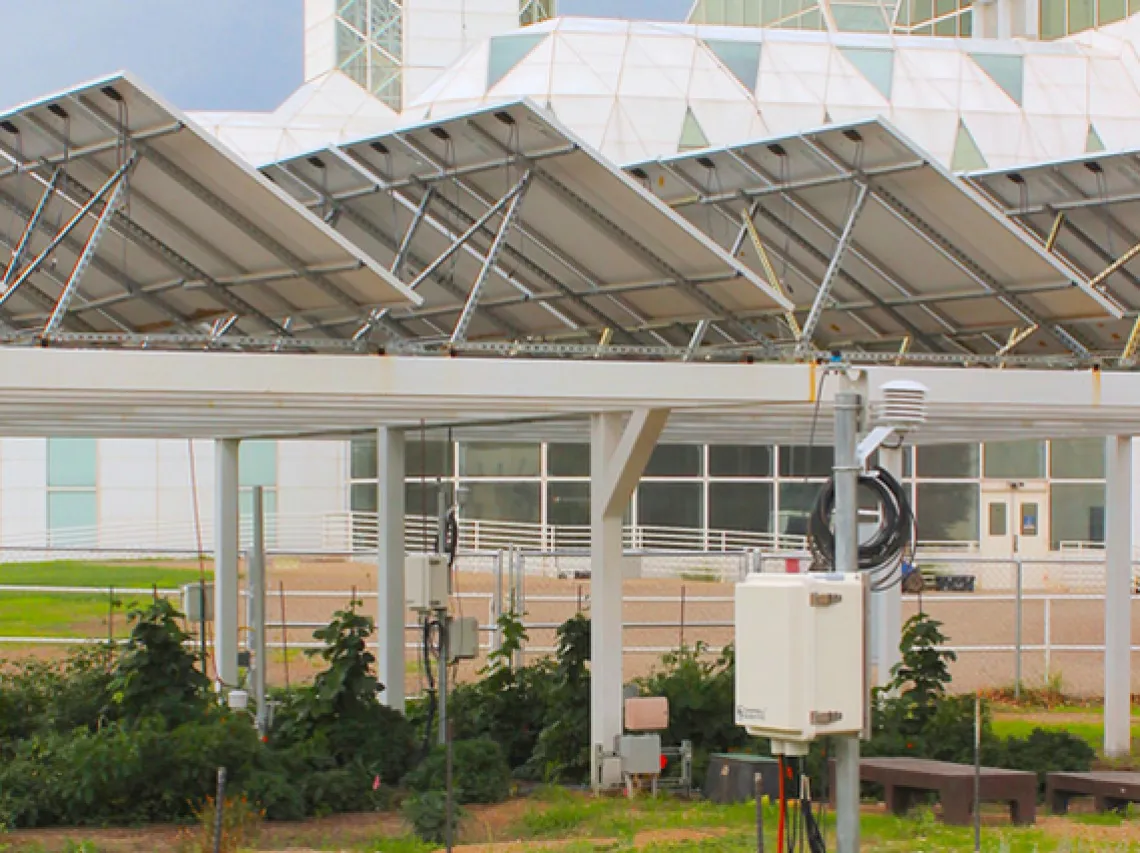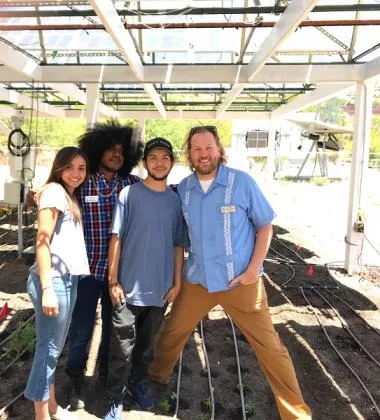Agrivoltaics Proves Mutually Beneficial Across Food, Water, Energy Nexus
A paper published in Nature Sustainability presents the first field-data assessment of outcomes of a multi-year study of agrivoltaics in dryland regions led by UA geographer Greg Barron-Gafford.

These results of a new UA-led study suggest that the novel co-location of agriculture and solar photovoltaic arrays could have synergistic effects that support the production of ecosystem services such as crop production, local climate regulation, water conservation and renewable energy production.
Building resilience in renewable energy and food production is a fundamental challenge in today's changing world, especially in regions susceptible to heat and drought. Agrivoltaics, the co-locating of agriculture and solar photovoltaic panels, offers a possible solution, with new University of Arizona-led research reporting positive impacts on food production, water savings and the efficiency of electricity production.
Agrivoltaics, also known as solar sharing, is an idea that has been gaining traction in recent years; however, few studies have monitored all aspects of the associated food, energy and water systems, and none have focused on dryland areas – regions that experience food production challenges and water shortages, but have an overabundance of sun energy.
“Many of us want more renewable energy, but where do you put all of those panels? As solar installations grow, they tend to be out on the edges of cities, and this is historically where we have already been growing our food,” said Greg Barron-Gafford, an associate professor in the School of Geography and Development and lead author on the paper that was published today in Nature Sustainability.
A recent high-profile study in Nature found that current croplands are the “land covers with the greatest solar PV power potential” based on an extensive analysis of incoming sunlight, air temperature and relative humidity.

“So which land use do you prefer – food or energy production? This challenge strikes right at the intersection of human-environment connections, and that is where geographers shine!" said Barron-Gafford, who is also a researcher with Biosphere 2. "We started to ask, ‘Why not do produce both in the same place?’ And we have been growing crops like tomatoes, peppers, chard, kale, and herbs in the shade of solar panels ever since.”
Using solar photovoltaic, or PV, panels and regional vegetables, the team created the first agrivoltaics research site at Biosphere 2. Professors and students, both undergraduate and graduate, measured everything from when plants germinated to the amount of carbon plants were sucking out of the atmosphere and the water they were releasing, to their total food production throughout the growing season.
The study focused on chiltepin pepper, jalapeno and cherry tomato plants that were positioned under a PV array. Throughout the average three-month summer growing season, researchers continuously monitored incoming light levels, air temperature and relative humidity using sensors mounted above the soil surface, and soil surface temperature and moisture at a depth of 5 centimeters. Both the traditional planting area and the agrivoltaic system received equal irrigation rates and were tested using two irrigation scenarios – daily irrigation and irrigation every second day.
They found that the agrivoltaics system significantly impacted three factors that affect plant growth and reproduction – air temperatures, direct sunlight and atmospheric demand for water. The shade provided by the PV panels resulted in cooler daytime temperatures and warmer nighttime temperatures than the traditional, open-sky planting system. There was also a lower vapor pressure deficit in the agrivoltaics system, meaning there was more moisture in the air.
"We found that many of our food crops do better in the shade of solar panels because they are spared from the direct sun," Baron-Gafford said. "In fact, total chiltepin fruit production was three times greater under the PV panels in an agrivoltaic system, and tomato production was twice as great!"
Jalapenos produced a similar amount of fruit in both the agrivoltaics system and the traditional plot, but did so with 65% less transpirational water loss.
"At the same time, we found that each irrigation event can support crop growth for days, not just hours, as in current agriculture practices. This finding suggests we could reduce our water use but still maintain levels of food production," Barron-Gafford added, noting that soil moisture remained approximately 15% higher in the agrivoltaics system than the control plot when irrigating every other day.
In addition to the benefits to the plants, the researchers also found that the agrivoltaics system increased the efficiency of energy production. Solar panels are inherently sensitive to temperature – as they warm, their efficiency drops. By cultivating crops underneath the PV panels, researchers were able to reduce the temperature of the panels.
"Those overheating solar panels are actually cooled down by the fact that the crops underneath are emitting water through their natural process of transpiration – just like misters on the patio of your favorite restaurant," Barron-Gafford said. "All told, that is a win-win-win in terms of bettering our how we grow our food, utilize our precious water resources, and produce renewable energy.”
Barron-Gafford's research into agrivoltaics has expanded to include several solar installations on Tucson Unified School District, or TUSD, land. Moses Thompson, who splits his time between the TUSD and the UA School of Geography and Development, notes that the team is also using the TUSD solar installations to engage with K-12 students.
“What draws me to this work is what happens to the K-12 learner when their involvement is consequential and the research lives in their community," Thompson said. "That shift in dynamics creates students who feel agency in addressing grand challenges such as climate change."
The authors say more research with additional plant species is needed. They also note the currently unexplored impact agrivoltaics could have on the physical and social well-bring of farm laborers. Preliminary data show that skin temperature can be about 18 degrees Fahrenheit cooler when working in an agrivoltaics area than in traditional agriculture.
“Climate change is already disrupting food production and farm worker health in Arizona,” said Gary Nabhan, an agroecologist in the UA Southwest Center and co-author on the paper. "The Southwestern U.S. sees a lot of heat stroke and heat-related death among our farm laborers; this could have a direct impact there, too."
Barron-Gafford and the team are now working with the U.S. Department of Energy’s National Renewable Energy Lab to assess how well an agrivoltaics approach can work in other regions of the country and how regional policies can promote adoption of novel approaches to solve these pervasive problems.
“This is UA innovation at its best – an interdisciplinary team of researchers working to address some of our most challenging environmental dilemmas," said co-author Andrea Gerlak, a professor in the School of Geography and Development in the College of Social and Behavioral Sciences. "Imagine the impact we can have in our community – and the larger world – by more creatively thinking about agriculture and renewable energy production together.”
Other co-authors from the UA include: Rebecca Minor, Leland Sutter, Isaiah Barnett-Moreno, Daniel Blackett and Kirk Diamond. Mitchell Pavao-Zuckerman of the University of Maryland and Jordan Macknick of the National Renewable Energy Laboratory also contributed to the research.
This study was funded in part by: National Science Foundation award No. 1659546, Research Experiences for Undergraduates Site: Earth Systems Research for Environmental Solutions at Biosphere 2; and the Department of Energy’s National Renewable Energy Lab through award No. REJ-7-70227.
##
Written by Stacy Pigott, University Communication. "Agrivoltaics Proves Mutually Beneficial Across Food, Water, Energy Nexus" originally posted on UANews.

